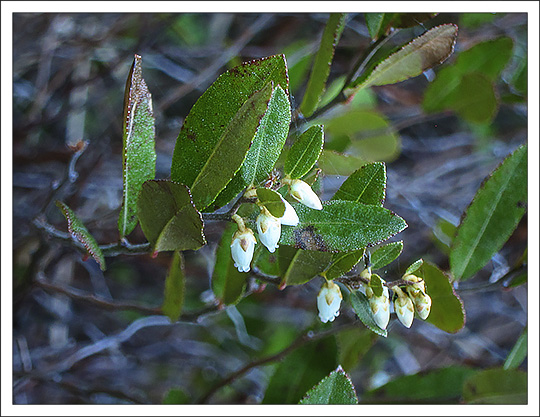Adirondack Shrubs:
Leatherleaf (Chamaedaphne calyculata)
 Adirondack Shrubs: Leatherleaf (Chamaedaphne calyculata) on the Heron Marsh Trail (7 May 2013)
Adirondack Shrubs: Leatherleaf (Chamaedaphne calyculata) on the Heron Marsh Trail (7 May 2013)
| This page is no longer being updated. For an updated and expanded version of this material, see: Leatherleaf (Chamaedaphne calyculata). |
Leatherleaf (Chamaedaphne calyculata) is a native evergreen shrub which produces small, bell-shaped white flowers in spring. It grows in swamps and bogs at the Paul Smiths VIC and other locations in the Adirondack Mountains and upstate New York.
Leatherleaf forms a small, mound-shaped shrub up to three feet high. The nodding white flowers are about 1/4 inch long and hang from the upper leaf axils in one-sided, spike-like clusters. The tubular flowers are wider at the top; the lips of the petals are rolled up at the bottom. The flowers sometimes have a pinkish tint. The leaves of the Leatherleaf are alternate and elongated oval or elliptical in shape. They are somewhat leathery in appearance. They generally are 3/4 to 1.5 inches long, and about 1/2 inch wide. The upper surfaces of the leaf are dark green with a smooth sheen; the undersides have small brown scales. Older leaves are brownish bronze above and yellowish beneath. The foliage often turns red-brown winter.
Leatherleaf is a member of the Heath Family (Ericaceae). The genus name -- Chamaedaphne -- comes from the Greek meaning "ground laurel." The common name -- Leatherleaf -- is a reference to the plant's tough, leather-like leaf. This plant is also known as Cassandra.
Leatherleaf is one of several leathery leafed plants growing in swampy or boggy habitats. Sheep Laurel and Bog Laurel both have opposite leaves, in contrast to Leatherleaf, which has alternate leaves. Labrador Tea also has alternate leaves, but its leaves have rolled leaf edges and are rusty-orange or white-wooly underneath. Bog Rosemary also has alternate leaves, but its leaves are narrow, have rolled edges, and are whitened underneath by tiny hairs.
Native American Indian tribes reportedly used Leatherleaf for medicinal purposes. Some tribes used an infusion of leaves for fevers and a poultice of leaves for inflammations. The fresh or dried leaves of Leatherleaf have also been used to make a tea-like beverage. However, some reports indicate that a toxin called andromedotoxin can be released from the plant if it is infused in boiling water. For that reason, it is recommended that the leaves be placed in a jar of cool water and left in a sunny position to brew.
Leatherleaf grows in bogs and swampy areas at the Paul Smiths VIC and other locations in the Adirondack Mountains and upstate New York. It prefers acid soil. The plant can be found in the north-eastern part of the US and most provinces of Canada.
At the Paul Smiths VIC, Leatherleaf may be seen along the margins of Heron Marsh, from the Heron Marsh Trail and Barnum Brook Trail, those portions of the Bobcat Trail and Logger's Loop Trail which skirt the marsh, as well as the Woods and Waters Trail (near the floating bridge) and the Jenkin’s Mountain Trail overlook. Leatherleaf also grows on Barnum Bog, accessible from the Boreal Life Trail boardwalk, and on the margins of Black Pond (from the Black Pond Trail) and Long Pond (from the Long Pond Trail). Leatherleaf usually blooms in this part of the Adirondack Park in May, depending on the weather.
References
- Lady Bird Johnson Wildflower Center. Native Plant Database.
- United States Department of Agriculture. Plants Database.
- University of Michigan. Native American Ethnobotany. A Database of Foods, Drugs, Dyes and Fibers of Native American Peoples, Derived from Plants.
- NatureServe Explorer. Online Encyclopedia of Life.
- Plants for a Future. Database.
- University of Wisconsin. Robert W. Freckmann Herbarium.
- University of Wisconsin. Shrubs of Wisconsin.
- Connecticut Wildflowers. Wildflower Guide.
- New York Flora Association. New York Flora Atlas.
- ENature. Wildflower Field Guide.
- Minnesota Wildflowers. Database.
- Doug Ladd. North Woods Wildflowers (Falcon Publishing, 2001), p. 182.
- Lawrence Newcomb. Newcomb's Wildflower Guide (Little Brown and Company, 1977), pp. 292-293.
- National Audubon Society. Field Guide to Wildflowers. Eastern Region. (Alfred A. Knopf, 2001), pp. 506-507.
- William K. Chapman, et al. Wildflowers of New York in Color (Syracuse University Press, 1998), pp. 38-39.
- William K. Chapman and Alan E. Bessette. Trees and Shrubs of the Adirondacks: A Field Guide (North Country Books, 1990), p. 95.
- Meiyin Wu and Dennis Kalma. Wetland Plants of the Adirondacks. Ferns, Woody Plants, and Graminoids(Trafford Publishing, 2010), pp. 83-84.
- John Krichner and Gordon Morrison. A Field Guide to Eastern Forests (Houghton Mifflin Company, 1998), pp. 68, 124, Plate 5.
